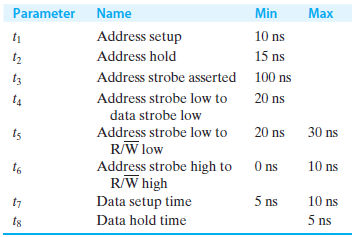(Solved): Figure P10.32a gives the timing diagram of a microprocessor during a write cycle. Figure P10.32b giv ...
Figure P10.32a gives the timing diagram of a microprocessor during a write cycle. Figure P10.32b gives the timing diagram of a memory-mapped peripheral during a write cycle. Using the timing information in Table P10.32, verify that the interface of Figure P10.32 will function correctly. Note that a memory-mapped peripheral is a peripheral that looks exactly like a block of static RAM as far as the processor is concerned (we cover such peripherals in Chapter 12). In this question, active-low signals are indicated by an asterisk rather than an overbar; for example, W* indicates NOT write.
TABLE P10.32
(a) Processor timing
(b) Peripheral timing
Figure P10.32
(a) Processor timing diagram
(b) Peripheral timing diagram
(c) Circuit of the CPU to peripheral interface
Note:
 = Address strobe (low when address from CPU valid)
= Address strobe (low when address from CPU valid)
 = Data strobe (low when data from CPU valid)
= Data strobe (low when data from CPU valid)
 = Read/not write (high in read cycle, low in write cycle)
= Read/not write (high in read cycle, low in write cycle)
 = Chip select (low when peripheral to take place in a read or write cycle)
= Chip select (low when peripheral to take place in a read or write cycle)
 = Write enable (low when peripheral to take place in a write cycle)
= Write enable (low when peripheral to take place in a write cycle)




